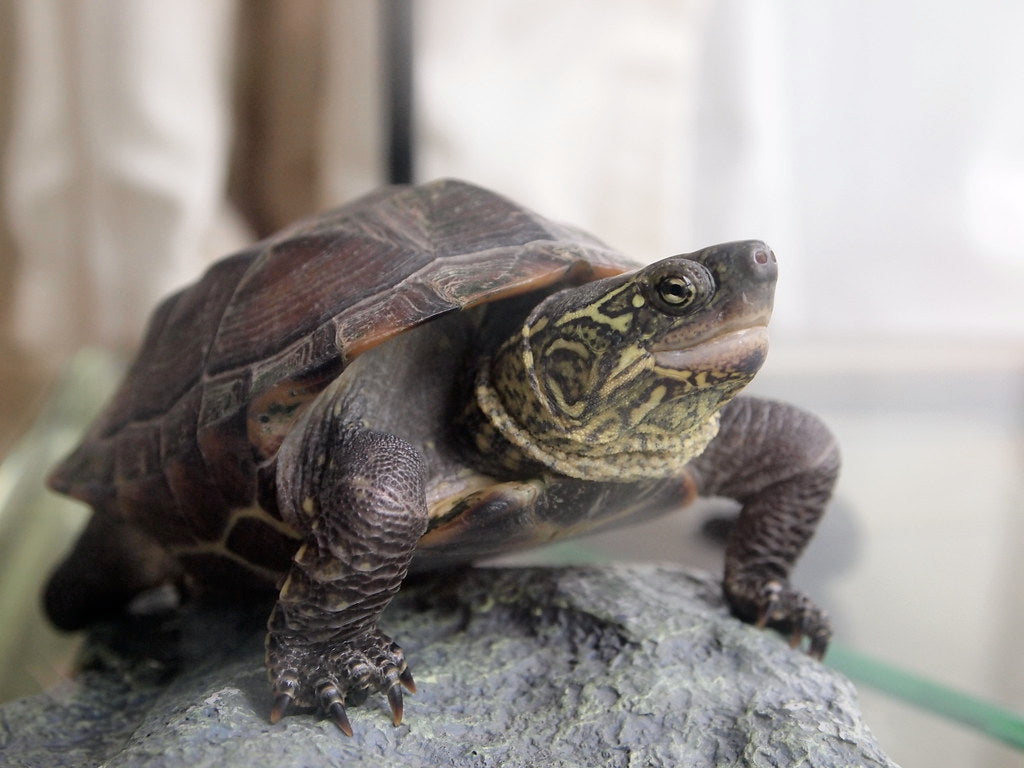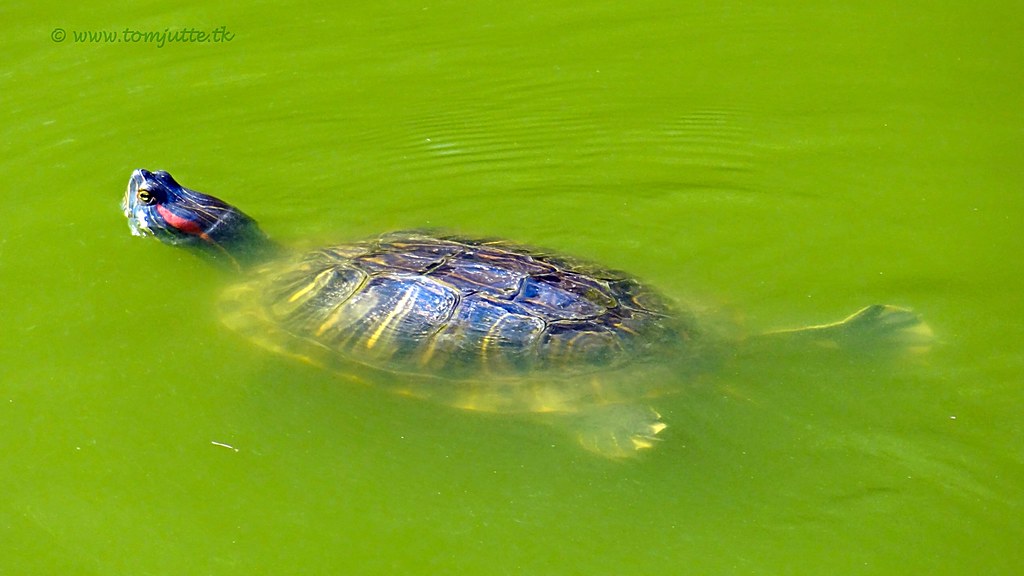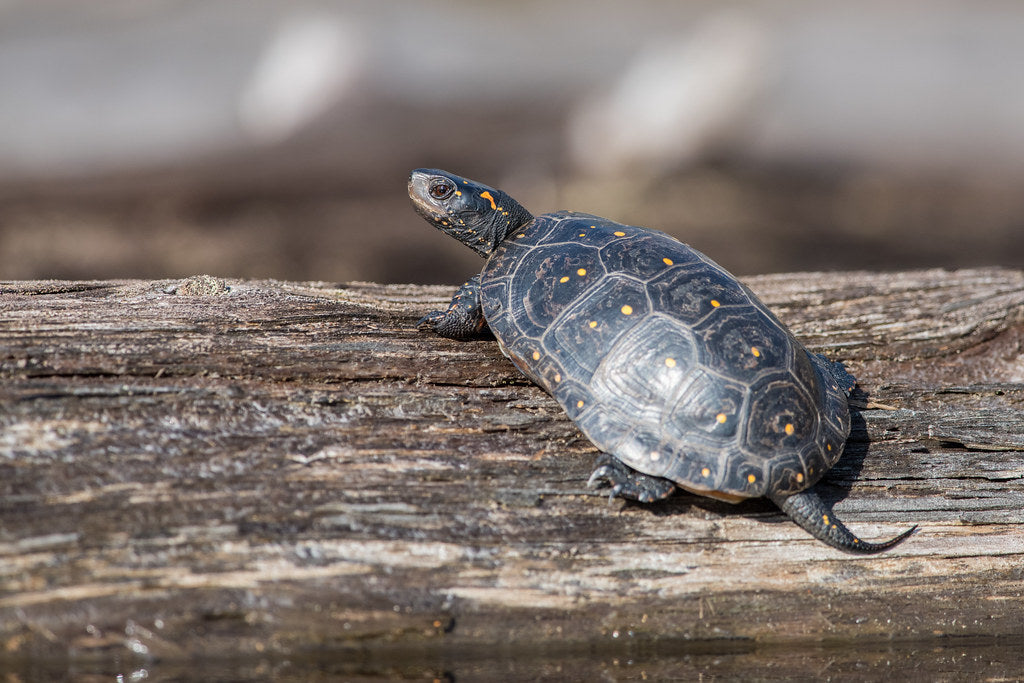Reeve’s Turtles (Mauremys reevesii) are medium-sized, semi-aquatic, diurnal reptiles native to east Asia. Like most freshwater turtles, they prefer habitats that feature bodies of slow-moving or still water with a soft bottom, basking opportunities, and plenty of aquatic vegetation. Hatchling Reeve’s turtles spend most of their time in the water, but adults are quite terrestrial.
Reeve’s turtles are reported to be able to grow as large as 12+ inches long, but they are typically more in the 5-6” range. Expected adult size varies according to locality. Appearance-wise, these turtles have a smooth shell with three longitudinal ridges, large blunt head, large eyes, and a long tail. Coloring is generally a brown to dark gray, with darker skin. Young and female individuals often have an irregular pattern of pale or yellow lines on their cheeks and neck.
Some say that the Reeve’s turtle is an ideal beginner-level pet turtle because of their size and personable dispositions. But they still have very specific enclosure requirements that can make them daunting pets. With proper care, this turtle can live at least 15-20 years.
How much space do Reeve’s turtles need?
Reeve’s turtles are amphibious and fairly active, so they need an enclosure that will appropriately accommodate both the aquatic and terrestrial aspects of their lifestyle.
With the wide range of potential adult sizes that applies to Reeve’s turtles, it’s best practice to buy from a reputable breeder and plan based on your turtle’s largest parent. The enclosure should be large enough to provide at least 10 gallons of water per inch of the turtle’s expected adult length. So, if your turtle’s largest parent is 6” long, then you will need at least 60 gallons of water. Although an aquarium can be adapted for the purpose, a Waterland tub is the best style of indoor enclosure for this species.
Like most turtles, Reeve’s turtles are likely to do best when housed outdoors where local climate permits, even if it’s just during part of the year. Outdoor housing is a convenient way to provide your turtle with plenty of both aquatic and terrestrial space, as well as “free” heating and lighting, but make sure the pond is fenced in and well secured against both escape and potential predators.
Multiple Reeve’s turtles can likely be housed together without conflict as long as there is adequate space for the turtles to bask, hide, and escape each other as needed.
Do Reeve’s turtles need UVB?
Reeve’s turtles require regular exposure to high-quality UVB in order to maintain optimal health and wellbeing. Providing UVB lighting to your turtle gives them all of the vitamin D that their body needs, stimulates better appetite and activity, and strengthens the immune system, as well as other benefits.
The best UVB bulbs for Reeve’s turtles are:
- Zoo Med Reptisun T5 HO 5.0
- Arcadia Forest 6%
The UVB bulb should be half the length of the enclosure and housed in a reflective fixture like the Arcadia ProT5 or Vivarium Electronics. Place the lamp close to the heat lamps, about 13-14” above the basking platform if there’s no mesh obstruction, but 8-11” away if there is mesh. UVB bulbs decay over time, so don’t forget to replace your bulb every 12 months to maintain good performance.
It’s also a good idea to provide a strong LED or T5 HO 6500K daylight lamp for additional illumination. This helps better replicate daylight and is also good for any live plants you may be using.
Lights should be on for 13 hours/day during summer and 11 hours/day during winter. If you are housing your turtle outdoors in an appropriate climate, supplementary lighting is not required.
What basking temperatures do Reeve’s turtles need?
Reeve’s turtles are ectotherms, which means that they rely on the variable temperatures of their environment to help regulate their metabolism and stay healthy. Here’s the range of temperatures a Reeve’s turtle’s indoor enclosure should offer:
- Basking (air temp): 95°F
- Water temp: 70-80°F
Measure basking temperature with a digital probe thermometer, and water temperature with a high-quality aquarium thermometer.
A good way to warm the basking area is with a couple of halogen flood heat lamps clustered on one side of the enclosure and positioned over the land portion of the enclosure for basking. Do not use ceramic heat emitters (CHEs), red bulbs, or blue bulbs, as these are not as effective. Increase the wattage if they’re too cool, and use a plug-in lamp dimmer if they’re too warm.
If you need to heat the water, use a high-quality aquarium heater rated for at least the maximum volume of water in the enclosure.
If you are housing your turtle outdoors, supplementary heating should not be required. However, they may need to be brought indoors for the winter once temperatures in your area get below 60°F.
What water conditions do Reeve’s turtles need?
Reeve’s turtles are semi-aquatic, which means that a significant portion of the enclosure should be water. Hatchling Reeve’s turtles are fairly weak swimmers, despite their highly aquatic nature, so the water should be quite shallow at 2” Once they’ve grown to 2.5” long, they should be able to handle up to 16” of water. Providing underwater “stopover” objects like submerged branches, terra cotta pots, etc. can help prevent drowning related to exhaustion.
The water must be kept clean at all times in order to keep your turtle healthy (and to keep the aquarium attractive). The most efficient way to do this is with a combination of excellent filtration and regular water changes. Aquatic turtles are fairly messy creatures, so you will need a canister-style filter capable of handling at least 2-3x the amount of water in the enclosure. So, if you have an aquarium or pond with 60 gallons of water, you will need a canister filter rated for at least 120 gallons of water. Don’t settle for the cheapest filter you can find — this is one aspect of your turtle’s enclosure not to skimp on!
Once every 1-2 weeks, remove and replace approximately 30% of the aquarium/pond’s total water volume. This helps minimize buildup of toxic compounds in the water that a filter is unable to resolve. To make the job easier, use a siphon or water pump.
Both indoor and outdoor turtle ponds require filtration and water changes.
Conditioning the water to remove chlorine and chloramines with a reptile-safe product such as Zoo Med ReptiSafe may be beneficial.
What substrate is good for Reeve’s turtles?
The land portion of the enclosure should offer several inches of semi moist, sandy soil. You can do this with Zoo Med Reptisoil or by mixing your own substrate with approximately 80% clean topsoil and 20% play sand (measured by volume).
Substrate is not required in the aquatic portion of the enclosure, although it does offer a form of enrichment when provided, encouraging natural behaviors. Sand and crushed coral are the best options. This must be cleaned with a siphon regularly, preferably at each water change. Avoid pebbles or gravel.
What decor can you use in a Reeve’s turtle enclosure?
The most essential piece of “decor” you will need in your turtle’s enclosure is going to be a land/haul-out area. This should be a partitioned-off area of land where the turtle can climb out of the water, bask, and explore. It’s best not to use a basking platform or turtle dock like can be used with other species. This is why Waterland tubs and outdoor ponds work best for housing Reeve’s turtles.
Aside from the haul-out area, there are additional ways you can increase the enclosure’s functionality and general attractiveness. Here are some ideas:
- live/artificial plants (aquatic and terrestrial)
- mopani wood
- hollow logs
- terracotta pots
Make sure your turtle has access to places where it can hide from view as needed. Hollow underwater hiding areas should be large enough that the turtle can’t get stuck, as this can lead to drowning!
What do Reeve’s turtles eat?
Reeve’s turtles have different nutrition needs based on their stage of life. Young individuals are highly carnivorous, but adults eat much more plant matter. In general, Reeve’s turtles are classified as omnivores, which means that they need to eat a balanced diet of both plant- and animal-based foods to get the nutrition that they need. Here is a general feeding schedule to follow:
Reeve’s turtles younger than 6 months:
- protein food or pellets daily
- vegetable food daily
Reeves turtles between 6-12 months:
- protein food or pellets every other day
- vegetable food daily
Reeves turtles older than 1 year:
- protein food or pellets 2-3x/week
- vegetable food daily
A portion of chopped/shredded vegetables should be roughly the same size as the turtle’s shell. A portion of pellets or protein food should be roughly the same size as the turtle’s head.
Animal-based foods for Reeve’s turtles: crickets, earthworms, dubias, freeze-dried shrimp/krill, frozen bloodworms, blackworms, silkworms, snails, guppies, mollies, platies, mosquito fish
Vegetable foods for Reeve’s turtles: collard greens, dandelion greens + flowers, endive, green leaf lettuce, kale, red leaf lettuce, romaine lettuce, duckweed, filamentous algae, water hyacinth, water lettuce
Pellets for Reeve’s turtles: Omega One Juvenile Turtle Pellets, Omega One Adult Turtle Sticks, Tetra ReptoMin, Zoo Med Natural Aquatic Turtle Food, Mazuri Aquatic Turtle Diet
For extra calcium, your turtle should have access to a cuttlebone or calcium block at all times.
Do Reeve’s turtles like to be handled?
Reeve’s turtles can be quite quick to recognize their keepers, and even personable. However, as a general rule, turtles do not like to be handled. Keep handling to a minimum unless it is absolutely necessary for inspection or transportation (ex: going to the vet for a checkup). If you would like to interact with your turtle, try hand-feeding it with a pair of feeding tongs.
*This care sheet contains only very basic information. Although it’s a good introduction, please do further research with high-quality sources to obtain additional information on caring for this species.
"enjoying the sun" by denn is licensed under CC BY-SA 2.0




Leave a comment
This site is protected by hCaptcha and the hCaptcha Privacy Policy and Terms of Service apply.